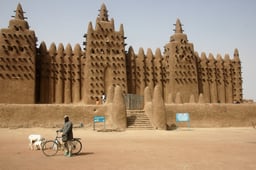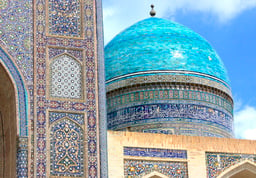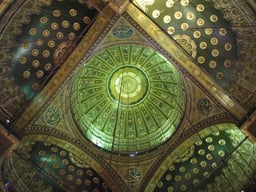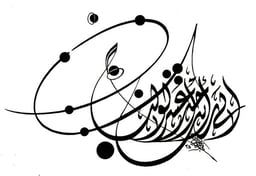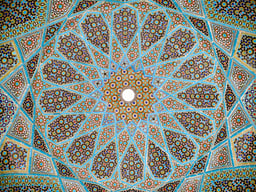Islam
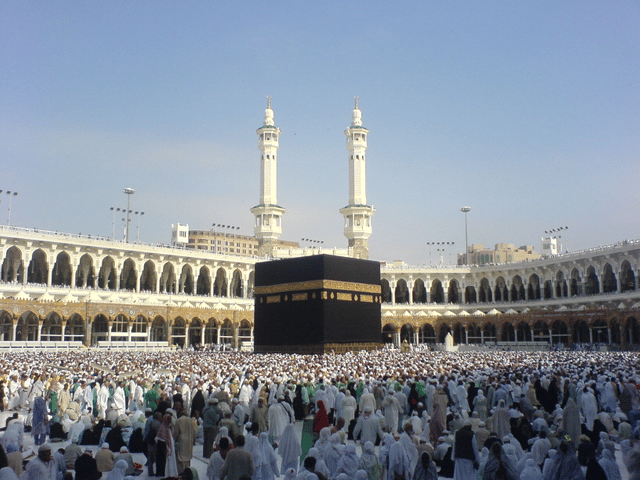
Islam
Islam (/ˈɪslɑːm/;[1] Arabic: ٱلْإِسْلَام, romanized: al-Islām [alʔɪsˈlaːm] ( listen)) is an Abrahamic, monotheistic religion teaching that there is only one God (Allah), and that Muhammad is a messenger of God.[3][4][4] It is the world's second-largest religion with over 1.9 billion followers or 24.4% of the world's population,[6] commonly known as Muslims.[7] Muslims make up a majority of the population in 50 countries.[8] Islam teaches that God is merciful, all-powerful, and unique,[9] and has guided mankind through prophets, revealed scriptures and natural signs.[4][10] The primary scriptures of Islam are the Quran, believed to be the verbatim word of God, and the teachings and normative examples (called the sunnah, composed of accounts called hadith) of Muhammad (c. 570 – 8 June 632 CE).[11]
Muslims believe that Islam is the complete and universal version of a primordial faith that was revealed many times before through prophets including Adam, Abraham, Moses and Jesus,[12][13][14] and the Quran in its Arabic to be the unaltered and final revelation of God.[15] Like other Abrahamic religions, Islam also teaches a final judgment with the righteous rewarded in paradise and unrighteous punished in hell.[16][17] Religious concepts and practices include the Five Pillars of Islam, which are obligatory acts of worship, and following Islamic law (sharia), which touches on virtually every aspect of life and society, from banking and welfare to women and the environment.[18][19][20] The cities of Mecca, Medina and Jerusalem are home to the three holiest sites in Islam.[21]
Aside from the theological narrative,[22][23][24] Islam is historically believed to have originated in the early 7th century CE in Mecca,[25] and by the 8th century the Umayyad Caliphate extended from Iberia in the west to the Indus River in the east. The Islamic Golden Age refers to the period traditionally dated from the 8th century to the 13th century, during the Abbasid Caliphate, when much of the historically Muslim world was experiencing a scientific, economic and cultural flourishing.[26][27][28] The expansion of the Muslim world involved various caliphates and empires such as the Ottoman Empire, trade and conversion to Islam by missionary activities (dawah).[29]
Most Muslims are of one of two denominations; Sunni (75–90%)[30] or Shia (10-20%).[30] About 13% of Muslims live in Indonesia, the largest Muslim-majority country;[32] 31% of Muslims live in South Asia,[33] the largest population of Muslims in the world;[34] 20% in the Middle East–North Africa region,[35] where it is the dominant religion;[36] and 15% in Sub-Saharan Africa and West Africa.[37] Sizeable Muslim communities are also found in the Americas, Caucasus, Central Asia, China, Europe, Mainland Southeast Asia, Philippines, and Russia.[38][undefined] Islam is the fastest-growing major religion in the world.[40][41][42]
Etymology and meaning
Islām (Arabic: إسلام) is a verbal noun originating from the triliteral root S-L-M which forms a large class of words mostly relating to concepts of wholeness, submission, sincerity, safeness, and peace.[43] In a religious context, it means "voluntary submission to God".[44][45] Islām is the verbal noun of Form IV of the root, and means "submission to God" or "surrender to God". Muslim, the word applied to an adherent of Islam, is the active participle of the same verb form, and means "submitter to God" or "one who surrenders to God". The word sometimes has distinct connotations in its various occurrences in the Quran. In some verses, there is stress on the quality of Islam as an internal spiritual state: "Whomsoever God desires to guide, He opens his heart to Islam."[46] Other verses connect Islam and religion (dīn) together: "Today, I have perfected your religion (dīn) for you; I have completed My blessing upon you; I have approved Islam for your religion."[47] Still others describe Islam as an action of returning to God—more than just a verbal affirmation of faith.[48] In the Hadith of Gabriel, islām is presented as one part of a triad that also includes imān (faith), and ihsān (excellence).[49][50]
Islam was historically called Muhammadanism in Anglophone societies. This term has fallen out of use and is sometimes said to be offensive because it suggests that a human being rather than God is central to Muslims' religion, parallel to Buddha in Buddhism.[51] Some authors, however, continue to use the term Muhammadanism as a technical term for the religious system as opposed to the theological concept of Islam that exists within that system.[52]
Articles of faith
Faith (Iman) in the Islamic creed (Aqidah) is often represented as the six articles of faith, notably spelled out in the Hadith of Gabriel.
Concept of God
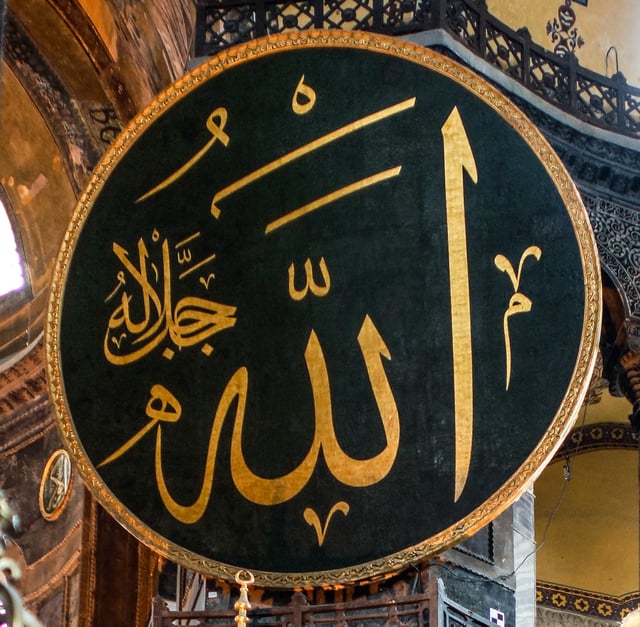
Medallion showing "Allah" (God) in Hagia Sophia, Istanbul, Turkey
Islam is often seen as having the simplest doctrines of the major religions.[42] Its most fundamental concept is a rigorous monotheism, called tawḥīd (Arabic: توحيد). God is described in chapter 112 of the Quran as: "Say, He is God, the One and Only; God, the Eternal, Absolute; He begetteth not, nor is He begotten; And there is none like unto Him" (112:1–4 [481] ).[53] Islam rejects polytheism and idolatry, called Shirk, and reject the Christian doctrine of the Trinity. In Islam, God is beyond all comprehension and thus Muslims are not expected to anthropomorphise him.[54][55][56][57] God is described and referred to by certain names or attributes, the most common being Al-Rahmān, meaning "The Compassionate" and Al-Rahīm, meaning "The Merciful" (See Names of God in Islam).[58]
Islam teaches that the creation of everything in the universe was brought into being by God's command as expressed by the wording, "Be, and it is"[59] and that the purpose of existence is to worship or to know God.[60][61] He is viewed as a personal god who responds whenever a person in need or distress calls him.[62] There are no intermediaries, such as clergy, to contact God who states, "I am nearer to him than (his) jugular vein."[63] God consciousness is referred to as Taqwa
Allāh is a term, with no plural or gender being ascribed, used by Muslims and Arabic-speaking Christians and Jews in reference to God, while ʾilāh (Arabic: إله) is a term used for a deity or a god in general.[64] Other non-Arab Muslims might use different names as much as Allah, for instance "Tanrı" in Turkish, "Khodā" in Persian or "Ḵẖudā" in Urdu.
Angels
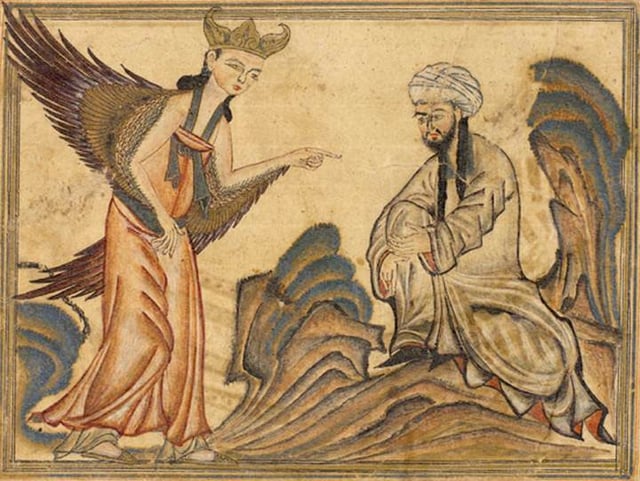
Muhammad receiving his first revelation from the angel Gabriel. From the manuscript Jami' al-tawarikh by Rashid-al-Din Hamadani, 1307, Ilkhanate period.
Belief in angels is fundamental to Islam. The Quranic word for angel (Arabic: ملك malak) derives either from Malaka, meaning "he controlled", due to their power to govern different affairs assigned to them,[65]Qur%CA%BCan%2C%20the%20Fundamental%20Law%20of%20Hum]]or from the root either from, or Greek (). Unlike their Hebrew counterpart, the term is exclusively used for heavenly spirits of the divine world, but not for human messengers. The Quran refers to both angelic and human messengers as "rasul" instead.[[66]](https://openlibrary.org/search?q=S.R.%20Burge%20 [[CITE|66|https://openlibrary.org/search?q=S.R.%20Burge%20*Journal%20of%20Qur'anic%20Studies%20The%20Angels)
The Quran is the principal source for the Islamic concept of angels.[67] Some of them, such as Gabriel and Michael, are mentioned by name in the Quran, others are only referred to by their function. In hadith literature, angels are often assigned to only one specific phenomena.[67][67]Islamic theology Islamic philosophy[67] xample, communicating revelations from God, glorifying God, recording every person's actions, and taking a person's soul at the time of death.
In Islam, just like in Judaism and Christianity, angels are often represented in anthropomorphic forms combined with supernatural images, such as wings, being of great size or wearing heavenly articles.[67] The Quran describes them as "messengers with wings—two, or three, or four (pairs)..."[72] Common characteristics for angels are their missing needs for bodily desires, such as eating and drinking.[73]Islam%3A%20A%20Worldwide%20Encyclopedia%20%5B4%20v]]Their lack of affinity to material desires is also expressed by their creation from light: Angels of mercy are created from (cold light) in opposition to the angels of punishment created from (hot light).[[74]](https://openlibrary.org/search?q=Jane%20Dammen%20McAuliffe%20 [[CITE|74|https://openlibrary.org/search?q=Jane%20Dammen%20McAuliffe%20*Encyclopaedia%20of%20the%20Qur%CA%BE%C4%81n) Muslims do not generally share the perceptions of angelic pictorial depictions, such as those found in Western art.
Revelations
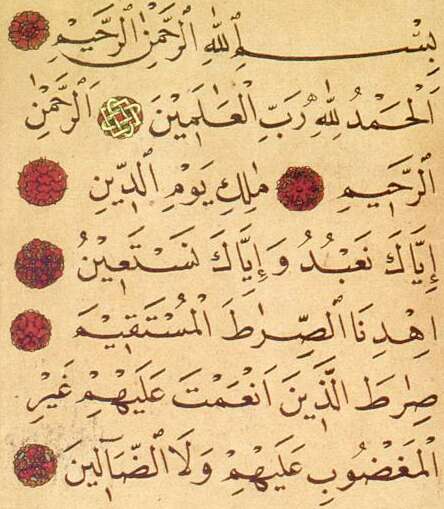
The first chapter of the Quran, Al-Fatiha (The Opening), is seven verses
The Islamic holy books are the records which most Muslims believe were dictated by God to various prophets.
Muslims believe that parts of the previously revealed scriptures, the Tawrat (Torah) and the Injil (Gospel), had become distorted—either in interpretation, in text, or both.[75] The Quran (literally, "Recitation") is viewed by Muslims as the final revelation and literal word of God and is widely regarded as the finest literary work in the classical Arabic language.[76][77]
Muslims believe that the verses of the Quran were revealed to Muhammad by God through the archangel Gabriel (Jibrīl) on many occasions between 610 CE until his death on June 8, 632.[78] While Muhammad was alive, all of these revelations were written down by his companions (sahabah), although the prime method of transmission was orally through memorization.[79]
The Quran is divided into 114 chapters (suras) which combined, contain 6,236 verses (āyāt). The chronologically earlier suras, revealed at Mecca, are primarily concerned with ethical and spiritual topics. The later Medinan suras mostly discuss social and legal issues relevant to the Muslim community.[80]
The Quran is more concerned with moral guidance than legislation, and is considered the "sourcebook of Islamic principles and values".[81] Muslim jurists consult the hadith ("reports"), or the written record of Prophet Muhammad's life, to both supplement the Quran and assist with its interpretation. The science of Quranic commentary and exegesis is known as tafsir.[82] elocution]] of recitation is called *.
Muslims usually view "the Quran" as the original scripture as revealed in Arabic and that any translations are necessarily deficient, which are regarded only as commentaries on the Quran.[83]
Prophets and sunnah
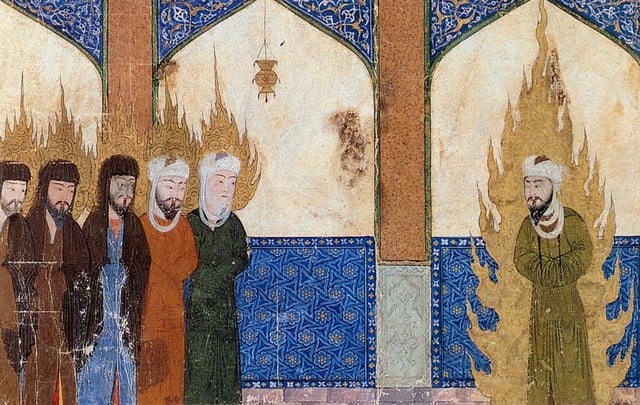
A Persian miniature depicts Muhammad leading Abraham, Moses, Jesus and other prophets in prayer.
Muslims identify the 'prophets' (Arabic: أنبياء anbiyāʾ ) of Islam as those humans chosen by God to be his messengers. According to the Quran, the prophets were instructed by God to bring the "will of God" to the peoples of the nations. Muslims believe that prophets are human and not divine, though some are able to perform miracles to prove their claim. Islamic theology says that all of God's messengers preached the message of Islam—submission to the will of God. The Quran mentions the names of numerous figures considered prophets in Islam, including Adam, Noah, Abraham, Moses and Jesus, among others.[84]
Muslims believe that God finally sent Muhammad as the last law-bearing prophet (Seal of the prophets) to convey the divine message to the whole world (to sum up and to finalize the word of God). In Islam, the "normative" example of Muhammad's life is called the sunnah (literally "trodden path"). Muslims are encouraged to emulate Muhammad's actions in their daily lives and the sunnah is seen as crucial to guiding interpretation of the Quran.[85]
A hadith involves two elements: a chain of narrators, called sanad, and the actual wording, called matn. Hadiths can be classified, by studying the narration, as "authentic" or "correct", called sahih (Arabic: صَحِيْح), "good", called hasan (Arabic: حَسَن) or "weak", called daʻīf (Arabic: ضَعِيْف) among others. Muhammad al-Bukhari[86] collected over 300,000 hadith, but only included 2,602 distinct hadith that passed veracity tests that codified them as authentic into his book Sahih al-Bukhari,[86] which is considered by Sunnis to be the most authentic source after the Quran.[87][88][89][90][91]
Resurrection and judgment
Belief in the "Day of Resurrection", Yawm al-Qiyāmah (Arabic: يوم القيامة) is also crucial for Muslims. They believe the time of Qiyāmah is preordained by God but unknown to man. The trials and tribulations preceding and during the Qiyāmah are described in the Quran and the hadith, and also in the commentaries of scholars. The Quran emphasizes bodily resurrection, a break from the pre-Islamic Arabian understanding of death.[92]
On Yawm al-Qiyāmah, Muslims believe all humankind will be judged on their good and bad deeds and consigned to Jannah (paradise) or Jahannam (hell). The Qurʼan in Surat al-Zalzalah describes this as, "So whoever does an atom's weight of good will see it (99:7) and whoever does an atom's weight of evil will see it (99:8)." The Qurʼan lists several sins that can condemn a person to hell, such as disbelief in God (Arabic: كفر kufr), and dishonesty; however, the Qurʼan makes it clear God will forgive the sins of those who repent if he so wills. Good deeds, such as charity, prayer and compassion towards animals,[93]%20By%20Basheer%20Ahmad%20Masri%20p.%2027]][[94]](https://openlibrary.org/search?q= [[CITE|94|https://openlibrary.org/search?q=What%20Everyone%20Needs%20to%20Know%20about%20Islam.%20Second%20)heaven ith Qurʼanic references describing its features. Mystical traditions in Islam place these heavenly delights in the context of an ecstatic awareness of God.[95] Yawm al-Qiyāmah is also identified in the Quran as Yawm ad-Dīn (Arabic: يوم الدين), "Day of Religion";[96] as-sāʿah (Arabic: الساعة), "the Last Hour";[97] and al-Qāriʿah (Arabic: القارعة), "The Clatterer".[98]
Divine will
The concept of divine will is referred to as al-qadāʾ wa l-qadar, which literally derives from a root that means to measure. Everything, good and bad, is believed to have been decreed.[99]
Acts of worship
There are five basic religious acts in Islam, collectively known as 'The Pillars of Islam' (arkan al-Islam; also arkan ad-din, "pillars of religion"), which are considered obligatory for all believers. The Quran presents them as a framework for worship and a sign of commitment to the faith. They are (1) the creed (Shahada), (2) daily prayers (Salah), (3) almsgiving (Zakat), (4) fasting during Ramadan (Sawm) and (5) the pilgrimage to Mecca (Hajj) at least once in a lifetime.[100] Both Shia and Sunni sects agree on the essential details for the performance of these acts.[101] Apart from these, Muslims also perform other religious acts. Notable among them are charity (Sadaqah) and recitation of the Quran.
Testimony
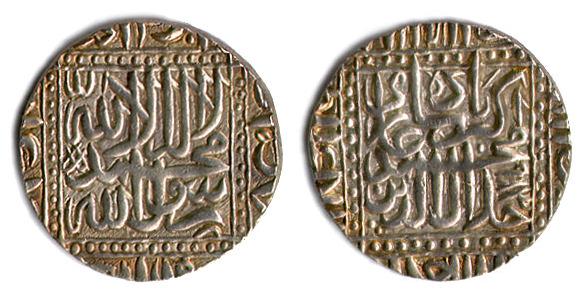
Silver coin of the Mughal Emperor Akbar the Great, inscribed with the Shahadah
The Shahadah,[102] which is the basic creed of Islam that must be recited under oath with the specific statement: "ʾašhadu ʾal-lā ʾilāha ʾillā-llāhu wa ʾašhadu ʾanna muħammadan rasūlu-llāh", or "I testify that there is no god but God, Muhammad is the messenger of God"[103] (أشهد أن لا إله إلا الله وأن محمدا رسول الله). This testament is a foundation for all other beliefs and practices in Islam. Muslims must repeat the shahadah in prayer, and non-Muslims wishing to convert to Islam are required to recite the creed.[104]
Prayer
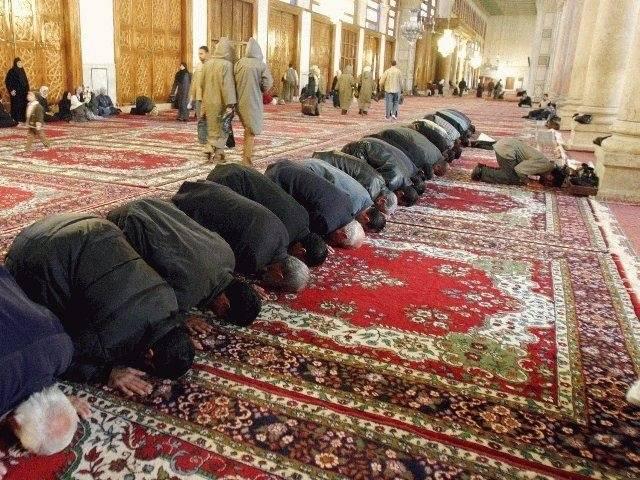
Muslim men prostrating in prayer, at the Umayyad Mosque, Damascus.
Ritual prayers are called Ṣalāh or Ṣalāt (Arabic: صلاة). Salat is intended to focus the mind on God, and is seen as a personal communication with him that expresses gratitude and worship. Performing prayers five times a day is compulsory but flexibility in the timing specifics is allowed depending on circumstances. The prayers are recited in the Arabic language, and consist of verses from the Quran.[105] The prayers are done with the chest in direction of the kaaba though in the early days of Islam, they were done in direction of Jerusalem. The act of supplicating is referred to as dua.
A Mosque is a place of worship for Muslims, who often refer to it by its Arabic name masjid. A large mosque for gathering for Friday prayers or Eid prayers are called masjid jāmi.[106] Although the primary purpose of the mosque is to serve as a place of prayer, it is also important to the Muslim community as a place to meet and study. In Medina, Al-Masjid al-Nabawi, or the Prophet's Mosque, was also a place of refuge for the poor.[107] Modern mosques have evolved greatly from the early designs of the 7th century, and contain a variety of architectural elements such as minarets.[108] The means used to signal the approach of prayer time is a vocal call, known as the adhan.
Charity
"Zakāt" (Arabic: زكاة zakāh "alms") is giving a fixed portion (2.5% annually)[109] of accumulated wealth by those who can afford it to help the poor or needy, such as for freeing captives or those in debt or (stranded) travellers, and for those employed to collect Zakat.[110][111] It is considered a religious obligation (as opposed to supererogatory charity) that the well-off owe to the needy because their wealth is seen as a "trust from God's bounty". Conservative estimates of annual zakat is estimated to be 15 times global humanitarian aid contributions.[112] The first Caliph Abu Bakr distributed Zakat as one of the first examples of a guaranteed minimum income, with each man, woman and child getting 10 to 20 dirhams annually.[113]
Sadaqah means optional charity which is practiced as religious duty and out of generosity.[114] Both the Quran and the hadith have put much emphasis on spending money for the welfare of needy people,[115] and have urged the Muslims to give more as an act of optional charity.[116] The Quran says: "Spend something (in charity) out of the substance which We have bestowed on you, before Death should come to any of you" (63:10 [482] ). One of the early teachings of Muhammad was that God expects men to be generous with their wealth and not to be miserly (Quran 107:1–7 [483] ).[117] Accumulating wealth without spending it to address the needs of the poor is generally prohibited and admonished.[115] Another kind of charity in Islam is waqf which means perpetual religious endowment.
Fasting
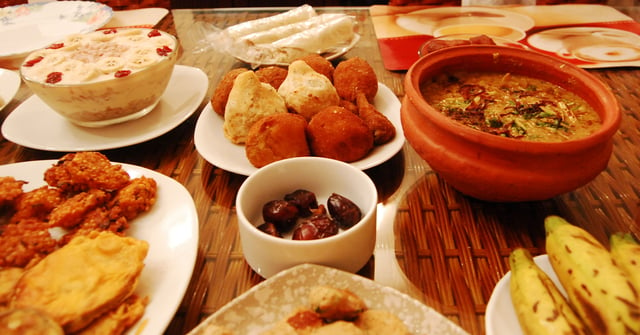
A fast-breaking feast, known as Iftar, is served traditionally with dates
Fasting (Arabic: صوم ṣawm) from food and drink, among other things, must be performed from dawn to after sunset during the month of Ramadan. The fast is to encourage a feeling of nearness to God, and during it Muslims should express their gratitude for and dependence on him, atone for their past sins, develop self-control and restraint and think of the needy. Sawm is not obligatory for several groups for whom it would constitute an undue burden. For others, flexibility is allowed depending on circumstances, but missed fasts must be compensated for later.[119]
Pilgrimage
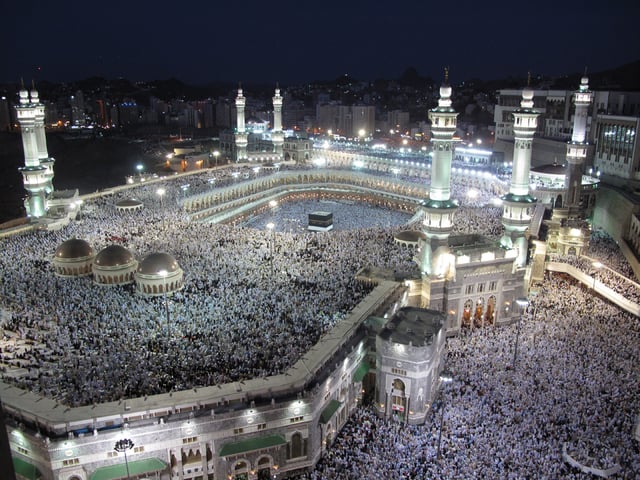
Pilgrims at the Masjid al-Haram in Mecca during Hajj
The obligatory Islamic pilgrimage, called the ḥajj (Arabic: حج), has to be performed during the Islamic month of Dhu al-Hijjah in the city of Mecca. Every able-bodied Muslim who can afford it must make the pilgrimage to Mecca at least once in his or her lifetime. Rituals of the Hajj include: spending a day and a night in the tents in the desert plain of Mina, then a day in the desert plain of Arafat praying and worshiping God, following the foot steps of Abraham; then spending a night out in the open, sleeping on the desert sand in the desert plain of Muzdalifah; then moving to Jamarat, symbolically stoning the Devil recounting Abraham's actions;[120][121][122] then going to Mecca and walking seven times around the Kaaba which Muslims believe was built as a place of worship by Abraham; then walking seven times between Mount Safa and Mount Marwah recounting the steps of Abraham's wife, Hagar, while she was looking for water for her son Ishmael in the desert before Mecca developed into a settlement.[123] Another form of pilgrimage, Umrah, can be undertaken at any time of the year.
Quranic recitation and memorisation
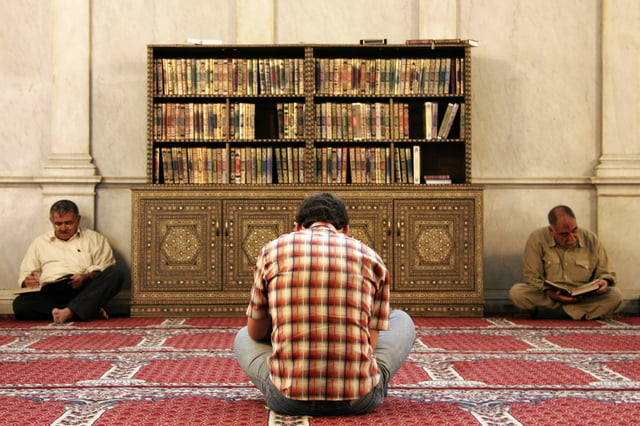
Muslim men reading the Quran
Muslims recite and memorize the whole or part of the Quran as acts of virtue.
Reciting the Quran with elocution has been described as an excellent act of worship.[124] Pious Muslims recite the whole Quran at the month of Ramadan.[115]Islamic%20Beliefs%20and%20Prac]]In Islamic societies, any social program generally begins with the recitation of the Quran.[[125]](https://openlibrary.org/search?q=Matt%20Stefon%2C%20ed.%20%282010%29.%20 [[CITE|115|https://openlibrary.org/search?q=Matt%20Stefon%2C%20ed.%20%282010%29.%20*Islamic%20Beliefs%20and%20Prac)hafiz Last Judgment Day.[124] Apart from this, almost every Muslim memorizes some portion of the Quran because they need to recite it during their prayers.
Law
Sharia is the religious law forming part of the Islamic tradition.[20] It is derived from the religious precepts of Islam, particularly the Quran and the Hadith. In Arabic, the term sharīʿah refers to God's divine law and is contrasted with fiqh, which refers to its scholarly interpretations.[126][127] The manner of its application in modern times has been a subject of dispute between Muslim traditionalists and reformists.[20]
Traditional theory of Islamic jurisprudence recognizes four sources of sharia: the Quran, sunnah (Hadith and Sira), qiyas (analogical reasoning), and ijma (juridical consensus).[128] Different legal schools developed methodologies for deriving sharia rulings from scriptural sources using a process known as ijtihad (inference).[126] Traditional jurisprudence distinguishes two principal branches of law, ʿibādāt (rituals) and muʿāmalāt (social relations), which together comprise a wide range of topics.[126] Its rulings assign actions to one of five categories: mandatory, recommended, permitted, abhorred, and prohibited.[126][127] Thus, some areas of sharia overlap with the Western notion of law while others correspond more broadly to living life in accordance with God's will.[127]
Historically, sharia was interpreted by independent jurists (muftis). Their legal opinions (fatwas) were taken into account by ruler-appointed judges who presided over qāḍī's courts, and by maẓālim courts, which were controlled by the ruler's council and administered criminal law.[126][127] In the modern era, sharia-based criminal laws were widely replaced by statutes inspired by European models.[127] The Ottoman Empire's 19th-century Tanzimat reforms lead to the Mecelle civil code and represented the first attempt to codify Sharia.[129] While the constitutions of most Muslim-majority states contain references to sharia, its classical rules were largely retained only in personal status (family) laws.[127] Legislative bodies which codified these laws sought to modernize them without abandoning their foundations in traditional jurisprudence.[127][130] The Islamic revival of the late 20th century brought along calls by Islamist movements for full implementation of sharia.[127][130] The role of sharia has become a contested topic around the world. There are ongoing debates as to whether sharia is compatible with secular forms of government, human rights, freedom of thought, and women's rights.[131][132][133]
Scholars
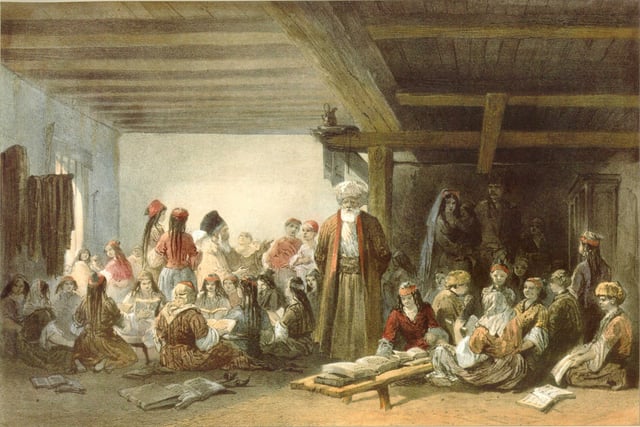
Crimean Tatar Muslim students (1856)
Islam, like Judaism, has no clergy in the sacerdotal sense, such as priests who mediate between God and people. However, there are many terms in Islam to refer to religiously sanctioned positions of Islam. In the broadest sense, the term ulema (Arabic: علماء) is used to describe the body of Muslim scholars who have completed several years of training and study of Islamic sciences. A jurist who interprets Islamic law is called a mufti (Arabic: مفتي) and often issues legal opinions, called fatwas. A scholar of jurisprudence is called a faqih (Arabic: فقيه). Someone who studies the science of hadith is called a muhaddith. A qadi is a judge in an Islamic court. Honorific titles given to scholars include sheikh, mullah and mawlawi. Imam (Arabic: إمام) is a leadership position, often used in the context of conducting Islamic worship services.
Schools of jurisprudence
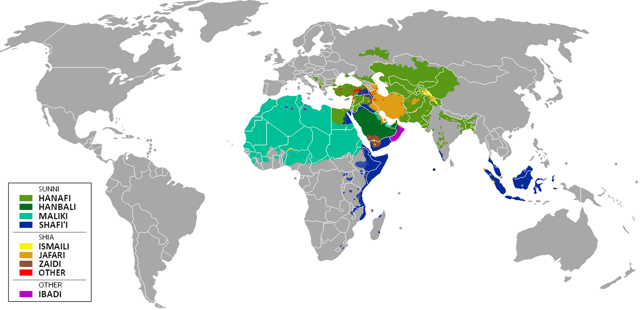
Islamic schools of law in the Muslim world
A school of jurisprudence is referred to as a madhab (Arabic: مذهب). The four major Sunni schools are the Hanafi, Maliki, Shafi'i, Hanbali and sometimes Ẓāhirī while the three major Shia schools are Ja'fari, Zaidi and Isma'ili. Each differ in their methodology, called Usul al-fiqh. The following of decisions by a religious expert without necessarily examining the decision's reasoning is called taqlid. The term ghair muqallid literally refers to those who do not use taqlid and by extension do not have a madhab.[134] The practice of an individual interpretating law with independent reasoning is called ijtihad.[135]
Economics
To reduce the gap between the rich and the poor, Islamic economic jurisprudence encourages trade,[136] discourages the hoarding of wealth and outlaws interest-bearing loans (usury; the term is riba in Arabic).[137][138] Therefore, wealth is taxed through Zakat, but trade is not taxed. Usury, which allows the rich to get richer without sharing in the risk, is forbidden in Islam. Profit sharing and venture capital where the lender is also exposed to risk is acceptable.[139] Hoarding of food for speculation is also discouraged.[140]
The taking of land belonging to others is also prohibited.
The prohibition of usury has resulted in the development of Islamic banking. During the time of Muhammad, any money that went to the state, was immediately used to help the poor. Then in 634, Umar formally established the welfare state Bayt al-mal. The Bayt al-mal or the welfare state was for the Muslim and Non-Muslim poor, needy, elderly, orphans, widows, and the disabled. The Bayt al-mal ran for hundreds of years under the Rashidun Caliphate in the 7th century and continued through the Umayyad period and well into the Abbasid era. Umar also introduced Child Benefit and Pensions for the children and the elderly.[141][142][143][144]
Jihad
Jihad means "to strive or struggle" (in the way of God).
Jihad, in its broadest sense, is "exerting one's utmost power, efforts, endeavors, or ability in contending with an object of disapprobation". Depending on the object being a visible enemy, the Devil, and aspects of one's own self (such as sinful desires), different categories of jihad are defined.[145] Jihad also refers to one's striving to attain religious and moral perfection.[146] When used without any qualifier, Jihad is understood in its military form.[147][148] Some Muslim authorities, especially among the Shi'a and Sufis, distinguish between the "greater jihad", which pertains to spiritual self-perfection, and the "lesser jihad", defined as warfare.[149]
Within Islamic jurisprudence, jihad is usually taken to mean military exertion against non-Muslim combatants.[150][151] Jihad is the only form of warfare permissible in Islamic law and may be declared against illegal works, terrorists, criminal groups, rebels, apostates, and leaders or states who oppress Muslims.[152][153] Most Muslims today interpret Jihad as only a defensive form of warfare.[154] Jihad only becomes an individual duty for those vested with authority. For the rest of the populace, this happens only in the case of a general mobilization.[153] For most Twelver Shias, offensive jihad can only be declared by a divinely appointed leader of the Muslim community, and as such is suspended since Muhammad al-Mahdi's occultation in 868 AD.[155][156]
Mysticism
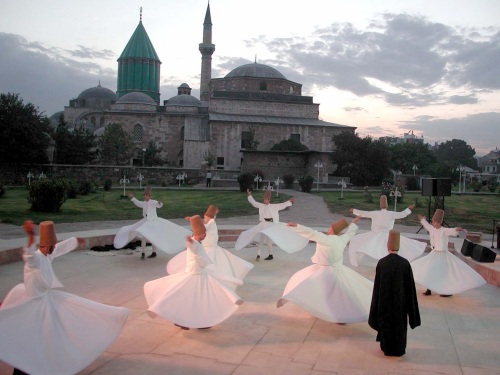
Tomb of Sufi-mystic Rumi in Konya, Turkey
Sufism, or tasawwuf (Arabic: تصوف), is a mystical-ascetic approach to Islam that seeks to find a direct personal experience of God. It is not a sect of Islam and its adherents belong to the various Muslim denominations. Classical Sufi scholars defined Tasawwuf as "a science whose objective is the reparation of the heart and turning it away from all else but God", by means of "intuitive and emotional faculties" that one must be trained to use.[157][158][159][159] Sufis themselves claim that Tasawwuf is an aspect of Islam similar to sharia, inseparable from Islam and an integral part of Islamic belief and practice.[160]
Religiousity of early Sufi ascetics, such as Hasan al-Basri, emphazised fear to fail God's expectations of obedience, in contrast to later and more prominent Sufis, such as Mansur Al-Hallaj and Jalaluddin Rumi, whose religiousity is based on love towards God. For that reason, some academic scholars refuse to refer to the former as Sufis.[161] Nevertheless, is Hasan al-Basri often portrayed as one of the earliest Sufis in Sufi traditions[162] and his ideas were later developed by the influential theologian Al-Ghazali. Traditional Sufis, such as Bayazid Bastami, Jalaluddin Rumi, Haji Bektash Veli, Junaid Baghdadi, and Al-Ghazali, argued for Sufism as being based upon the tenets of Islam and the teachings of the prophet.[163][164] Sufis played an important role in the formation of Muslim societies through their missionary and educational activities.[165][166]
Popular devotional practices such as veneration of Sufi saints have faced stiff opposition from followers of Wahhabism, who have sometimes physically attacked Sufis leading to deterioration in Sufi–Salafi relations. Sufism enjoyed a strong revival in Central Asia and South Asia; the Barelvi movement is Sufi influenced Sunni Islam with over 200 million followers,[167] largely in South Asia.[168][169] Sufism is also prominent is Central Asia, where different orders are the main religious sources,[[170]](http://pu.edu.pk/images/journal/uoc/PDF-FILES/(2)%20The%20Significant%20Role%20of%20Sufism%20in%20Central%20Asia%20(Dr.%20Farh.pdf)[171] as well as in African countries such as Tunisia, Algeria, Morocco, Senegal, Chad and Niger.[172][173]
Mystical interpretations of Islam have also been developed by Ismaili Shias, by the School of Illumination, as well as by the Isfahan school of philosophy.[174]
Society
Family life
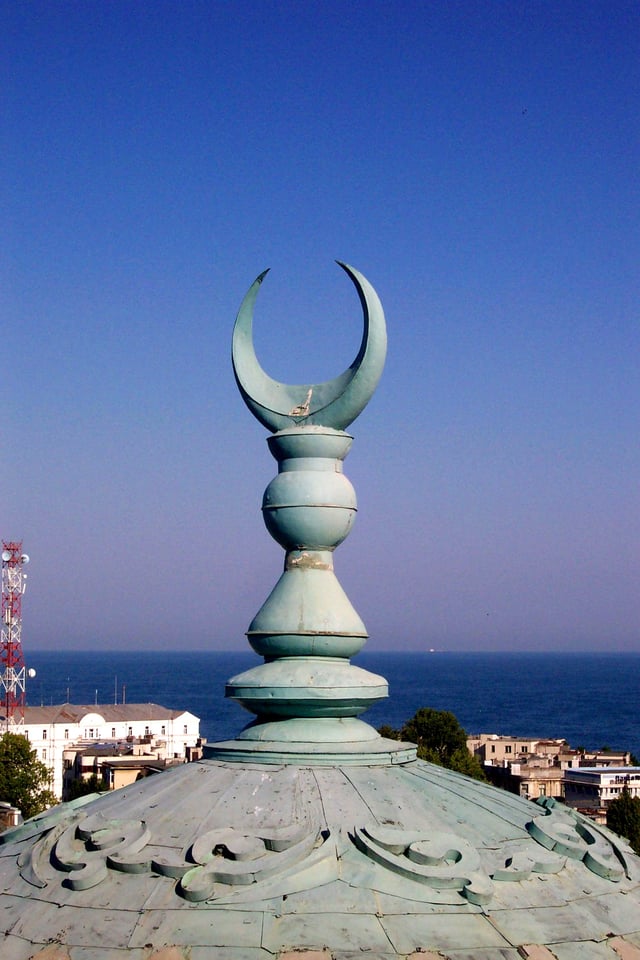
The dome of the Carol I Mosque in Constanța, Romania, topped by the Islamic crescent
In a Muslim family, the birth of a child is attended with some religious ceremonies.
Immediately after the birth, the words of Adhan is pronounced in the right ear of the child.[175] In the seventh day, the aquiqa ceremony is performed, in which an animal is sacrificed and its meat is distributed among the poor.[176] The head of the child is also shaved, and an amount of money equaling the weight of the child's hair is donated to the poor.[176] Apart from fulfilling the basic needs of food, shelter, and education, the parents or the elderly members of family also undertake the task of teaching moral qualities, religious knowledge, and religious practices to the children.[177] Marriage, which serves as the foundation of a Muslim family, is a civil contract which consists of an offer and acceptance between two qualified parties in the presence of two witnesses. The groom is required to pay a bridal gift (mahr) to the bride, as stipulated in the contract.[178] Most families in the Islamic world are monogamous.[179][180] Polyandry, a practice wherein a woman takes on two or more husbands is prohibited in Islam.[181] However, Muslim men are allowed to practice polygyny, that is, they can have more than one wife at the same time, up to a total of four, per Surah 4 Verse 3. A man does not need approval of his first wife for a second marriage as there is no evidence in the Qur'an or hadith to suggest this. With Muslims coming from diverse backgrounds including 49 Muslim-majority countries, plus a strong presence as large minorities throughout the world there are many variations on Muslim weddings. Generally in a Muslim family, a woman's sphere of operation is the home and a man's corresponding sphere is the outside world. However, in practice, this separation is not as rigid as it appears.[182] With regard to inheritance, a son's share is double that of a daughter's.[183]
Certain religious rites are performed during and after the death of a Muslim. Those near a dying man encourage him to pronounce the Shahada as Muslims want their last word to be their profession of faith. After the death, the body is appropriately bathed by the members of the same gender and then enshrouded in a threefold white garment called kafan.[115] Placing the body on a bier, it is first taken to a mosque where funeral prayer is offered for the dead person, and then to the graveyard for burial.
Etiquette and diet
Many practices fall in the category of adab, or Islamic etiquette. This includes greeting others with "as-salamu 'alaykum" ("peace be unto you"), saying bismillah ("in the name of God") before meals, and using only the right hand for eating and drinking. Islamic hygienic practices mainly fall into the category of personal cleanliness and health. Circumcision of male offspring is also practiced in Islam. Islamic burial rituals include saying the Salat al-Janazah ("funeral prayer") over the bathed and enshrouded dead body, and burying it in a grave. Muslims are restricted in their diet. Prohibited foods include pork products, blood, carrion, and alcohol. All meat must come from a herbivorous animal slaughtered in the name of God by a Muslim, Jew, or Christian, with the exception of game that one has hunted or fished for oneself. Food permissible for Muslims is known as halal food.[185]
Social responsibilities
In a Muslim society, various social service activities are performed by the members of the community.
As these activities are instructed by Islamic canonical texts, a Muslim's religious life is seen incomplete if not attended by service to humanity.[115]Islamic%20Beliefs%20and%20Prac]]In fact, In Islamic tradition, the idea of social welfare has been presented as one of its principal values.[[186]](https://openlibrary.org/search?q=Matt%20Stefon%2C%20ed.%20%282010%29.%20 [[CITE|115|https://openlibrary.org/search?q=Matt%20Stefon%2C%20ed.%20%282010%29.%20*Islamic%20Beliefs%20and%20Prac)[116][187][2] to parents, neighbors, relatives, sick people, the old, and minorities have been defined in Islam. Respecting and obeying one's parents, and taking care of them especially in their old age have been made a religious obligation.[177][188] A two-fold approach is generally prescribed with regard to duty to relatives: keeping good relations with them, and offering them financial help if necessary.[189] Severing ties with them has been admonished. Regardless of a neighbor's religious identity, Islam teaches Muslims to treat neighboring people in the best possible manner and not to cause them any difficulty.[190][191] Concerning orphaned children, the Quran forbids harsh and oppressive treatment to them while urging kindness and justice towards them. It also rebukes those who do not honor and feed orphaned children (Quran 89:17–18 [485] ).
Character
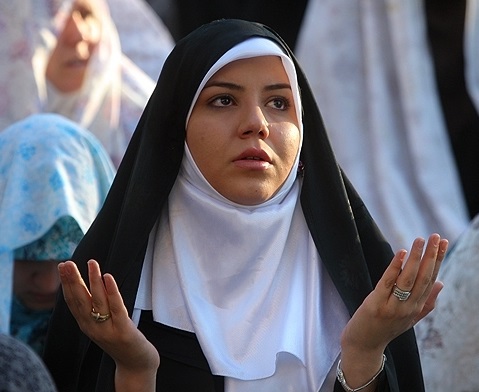
The Hijab represents modesty
The Quran and the sunnah of Muhammad prescribe a comprehensive body of moral guidelines for Muslims to be followed in their personal, social, political, and religious life. Proper moral conduct, good deeds, righteousness, and good character come within the sphere of the moral guidelines.[192] In Islam, the observance of moral virtues is always associated with religious significance because it elevates the religious status of a believer[193] and is often seen as a supererogatory act of worshipping.[194] One typical Islamic teaching on morality is that imposing a penalty on an offender in proportion to their offense is permissible and just; but forgiving the offender is better. To go one step further by offering a favor to the offender is regarded the highest excellence.[193] The Quran says: 'Repel (evil) with what is best' (41:34 [486] ). Thus, a Muslim is expected to act only in good manners as bad manners and deeds earn vices.[195] The fundamental moral qualities in Islam are justice, forgiveness, righteousness, kindness, honesty, and piety.[192] Other mostly insisted moral virtues include but not limited to charitable activities, fulfillment of promise, modesty (haya) and humility, decency in speech, tolerance, trustworthiness, patience, truthfulness, anger management, and sincerity of intention.
As a religion, Islam emphasizes the idea of having a good character as Muhammad said: 'The best among you are those who have the best manners and character' (Sahih al-Bukhari, 8:73:56 [487] ). In Islam, justice is not only a moral virtue but also an obligation to be fulfilled under all circumstances.[196] The Quran and the hadith describe God as being kind and merciful to His creatures, and tell people to be kind likewise. As a virtue, forgiveness is much celebrated in Islam, and is regarded as an important Muslim practice.[197] About modesty, Muhammad is reported as saying: ' Every religion has its characteristic, and the characteristic of Islam is modesty'.[198]
Government
Mainstream Islamic law does not distinguish between "matters of church" and "matters of state"; the scholars function as both jurists and theologians. Currently no government conforms to Islamic economic jurisprudence, but steps have been taken to implement some of its tenets.[199][200][201] Sunni and Shia sectarian divide also effects intergovernmental Muslim relations such as between Saudi Arabia and Iran.[202]
History
Muhammad (610–632)
Muslim tradition views Muhammad (c. 570 – June 8, 632) as the seal of the prophets.[203] During the last 22 years of his life, beginning at age 40 in 610 CE, according to the earliest surviving biographies, Muhammad reported revelations that he believed to be from God, conveyed to him through the archangel Gabriel. Muhammad's companions memorized and recorded the content of these revelations, known as the Quran.[204]
During this time, Muhammad in Mecca preached to the people, imploring them to abandon polytheism and to worship one God. Although some converted to Islam, the leading Meccan authorities persecuted Muhammad and his followers. This resulted in the Migration to Abyssinia of some Muslims (to the Aksumite Empire). Many early converts to Islam were the poor, foreigners and former slaves like Bilal ibn Rabah al-Habashi who was black. The Meccan élite felt that Muhammad was destabilising their social order by preaching about one God and about racial equality, and that in the process he gave ideas to the poor and to their slaves.[205][206][207][208]
After 12 years of the persecution of Muslims by the Meccans and the Meccan boycott of the Hashemites, Muhammad's relatives, Muhammad and the Muslims performed the Hijra ("emigration") to the city of Medina (formerly known as Yathrib) in 622. There, with the Medinan converts (Ansar) and the Meccan migrants (Muhajirun), Muhammad in Medina established his political and religious authority. The Constitution of Medina was formulated, instituting a number of rights and responsibilities for the Muslim, Jewish, Christian and pagan communities of Medina, bringing them within the fold of one community—the Ummah.[209][210]
The Constitution established:
the security of the community
religious freedoms
the role of Medina as a sacred place (barring all violence and weapons)
the security of women
stable tribal relations within Medina
a tax system for supporting the community in time of conflict
parameters for exogenous political alliances
a system for granting protection of individuals
a judicial system for resolving disputes where non-Muslims could also use their own laws and have their own judges.[211][212][213]
All the tribes signed the agreement to defend Medina from all external threats and to live in harmony amongst themselves.
Within a few years, two battles took place against the Meccan forces: first, the Battle of Badr in 624—a Muslim victory, and then a year later, when the Meccans returned to Medina, the Battle of Uhud, which ended inconclusively.
The Arab tribes in the rest of Arabia then formed a confederation and during the Battle of the Trench (March–April 627) besieged Medina, intent on finishing off Islam. In 628, the Treaty of Hudaybiyyah was signed between Mecca and the Muslims and was broken by Mecca two years later. After the signing of the Treaty of Hudaybiyyah many more people converted to Islam. At the same time, Meccan trade routes were cut off as Muhammad brought surrounding desert tribes under his control.[214] By 629 Muhammad was victorious in the nearly bloodless conquest of Mecca, and by the time of his death in 632 (at the age of 62) he had united the tribes of Arabia into a single religious polity.[215]
The earliest three generations of Muslims are known as the Salaf, with the companions of Muhammad being known as the Sahaba. Many of them, such as the largest narrator of hadith Abu Hureyrah, recorded and compiled what would constitute the sunnah.
Caliphate and civil strife (632–750)
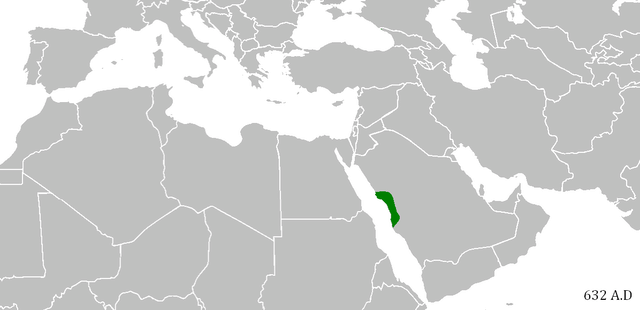
Rashidun and Umayyad expansion
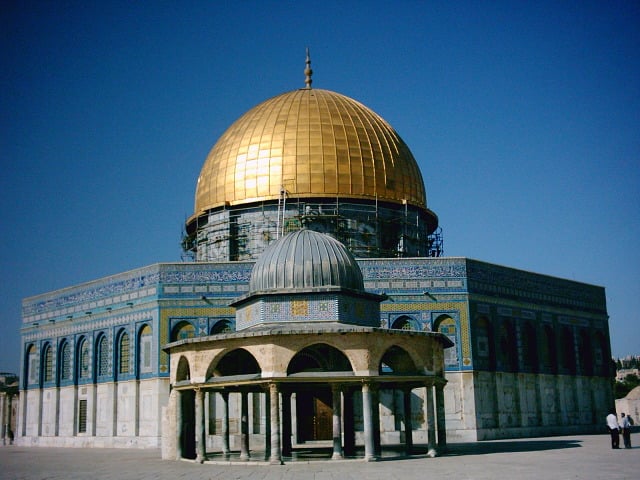
Dome of the Rock built by Abd al-Malik ibn Marwan; completed at the end of the Second Fitna
With Muhammad's death in 632, disagreement broke out over who would succeed him as leader of the Muslim community.
Abu Bakr, a companion and close friend of Muhammad, was made the first caliph. Under Abu Bakr, Muslims put down a rebellion by Arab tribes in an episode known as the Ridda wars, or "Wars of Apostasy".[216] The Quran was compiled into a single volume at this time.
Abu Bakr's death in 634 resulted in the succession of Umar ibn al-Khattab as the caliph, followed by Uthman ibn al-Affan, Ali ibn Abi Talib and Hasan ibn Ali. The first four caliphs are known in Sunni Islam as al-khulafā' ar-rāshidūn ("Rightly Guided Caliphs").[217] Under them, the territory under Muslim rule expanded deeply into the parts of the Persian and Byzantine territories.[218]
When Umar was assassinated by Persians in 644, the election of Uthman as successor was met with increasing opposition. The standard copies of the Quran were also distributed throughout the Islamic State. In 656, Uthman was also killed, and Ali assumed the position of caliph. This led to the first civil war (the "First Fitna") over who should be caliph. Ali was assassinated by Kharijites in 661. To avoid further fighting, the new caliph Hasan ibn Ali signed a peace treaty, abdicating to Mu'awiyah, beginning the Umayyad dynasty, in return that he not name his own successor.[219] These disputes over religious and political leadership would give rise to schism in the Muslim community. The majority accepted the legitimacy of the first four leaders and became known as Sunnis. A minority disagreed, and believed that only Ali and some of his descendants should rule; they became known as the Shia.[220] Mu'awiyah appointed his son, Yazid I, as successor and after Mu'awiyah's death in 680, the "Second Fitna" broke out, where Husayn ibn Ali was killed at the Battle of Karbala, a significant event in Shia Islam. Sunni Islam and Shia Islam thus differ in some respects.[221]
The Umayyad dynasty conquered the Maghreb, the Iberian Peninsula, Narbonnese Gaul and Sindh.[222] Local populations of Jews and indigenous Christians, persecuted as religious minorities and taxed heavily to finance the Byzantine–Sassanid Wars, often aided Muslims to take over their lands from the Byzantines and Persians, resulting in exceptionally speedy conquests.[223][224]
The generation after the death of Muhammad but contemporaries of his companions are known as the Tabi'un, followed by the Tabi‘ al-Tabi‘in. The Caliph Umar ibn Abd al-Aziz set up the influential committee, "The Seven Fuqaha of Medina",[225][226] headed by Qasim ibn Muhammad ibn Abi Bakr.[225] Malik ibn Anas wrote one of the earliest books on Islamic jurisprudence, the Muwatta,[228] as a consensus of the opinion of those jurists.[229][230][231]
The descendants of Muhammad's uncle Abbas ibn Abd al-Muttalib rallied discontented non-Arab converts (mawali), poor Arabs, and some Shi'a against the Umayyads and overthrew them, inaugurating the Abbasid dynasty in 750.[232]
The first Muslim states independent of a unified Islamic state emerged from the Berber Revolt (739/740-743).
Classical era (750–1258)
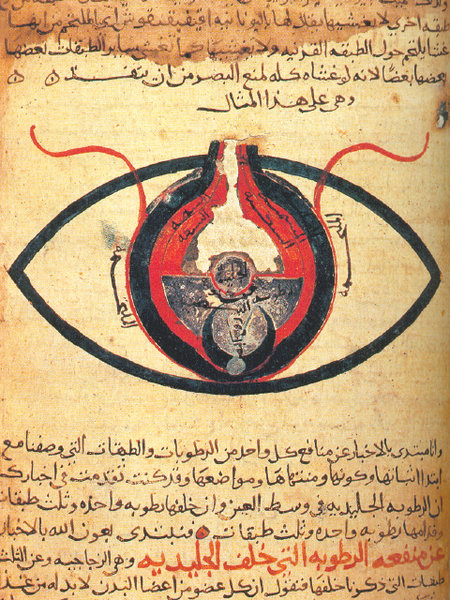
The eye, according to Hunain ibn Ishaq from a manuscript dated circa 1200
Al-Shafi'i codified a method to determine the reliability of hadith.[233] During the early Abbasid era, the major Sunni hadith collections were compiled by scholars such as Bukhari and Muslim while major Shia hadith collections by scholars such as Al-Kulayni and Ibn Babawayh were also compiled. The Ja'fari jurisprudence was formed from the teachings of Ja'far al-Sadiq while the four Sunni Madh'habs, the Hanafi, Hanbali, Maliki and Shafi'i, were established around the teachings of Abū Ḥanīfa, Ahmad bin Hanbal, Malik ibn Anas and al-Shafi'i respectively. In the 9th century, al-Shafi'i provided a theoretical basis for Islamic law and introduced its first methods by a synthesis between proto-rationalism of Iraqian jurisprudence and the pragmatic approach of the Hejaz traditions, in his book ar-Risālah.[234] However, Islamic law was not codified until 1869.[235] In the 9th century Al-Tabari completed the first commentary of the Quran, that became one of the most cited commentaries in Sunni Islam, the Tafsir al-Tabari. During its expansion through the Samanid Empire, Islam was shaped by the ethno-cultural and religious pluralism by the Sogdians, paving the way for a Persianized rather than Arabized understanding of Islam.[236]
Some Muslims began to question the piety of indulgence in a worldly life and emphasised poverty, humility and avoidance of sin based on renunciation of bodily desires. Ascetics such as Hasan al-Basri would inspire a movement that would evolve into Tasawwuf (Sufism).[237]
By the end of the 9th century, the Ismaili spread in Iran, whereupon the city Multan became target by activistic Sunni politics.[238] In 930, the Ismaili group known as the Qarmatians unsuccessfully rebelled against the Abbassids, sacked Mecca and stole the Black Stone, which was eventually retrieved.[239]
Caliphs such as Mamun al Rashid and Al-Mu'tasim made the mutazilite philosophy an official creed and imposed it upon Muslims to follow. Mu'tazila was a Greek influenced school of Sunni scholastic theology called kalam, which refers to dialectic.[240] Many orthodox Muslims rejected mutazilite doctrines and condemned their idea of the creation of the Quran. In inquisitions, ibn Hanbal refused to conform and was tortured and sent to an unlit Baghdad prison cell for nearly thirty months.[241] Other branches of kalam were the Ash'ari school founded by Al-Ash'ari and Maturidi founded by Abu Mansur al-Maturidi.
With the expansion of the Abbaside Caliphate into the Sasanian Empire, Islam adapted many Hellenistic and Persian concepts, imported by thinkers of Iranian or Turkic origin.[242][243] Philosophers such as Al-Farabi and Avicenna sought to incorporate Greek principles into Islamic theology, while others like Al-Ghazali argued against such syncretism and ultimately prevailed.[244] Avicenna pioneered the science of experimental medicine,[245] and was the first physician to conduct clinical trials.[246] His two most notable works, The Book of Healing and The Canon of Medicine, were used as standard medicinal texts in the Islamic world and later in Europe. Amongst his contributions are the discovery of the contagious nature of infectious diseases,[245] and the introduction of clinical pharmacology.[247] In mathematics, the mathematician Muhammad ibn Musa al-Khwarizmi gave his name to the concept of the algorithm, while the term algebra is derived from al-jabr.[248] The Persian poet Ferdowsi wrote his epic poem Shahnameh. Rumi wrote some of the finest Persian poetry and is still one of the best selling poets in America.[249][250] Legal institutions introduced include the trust and charitable trust (Waqf).[251][252]
This era is sometimes called the "Islamic Golden Age".[253] Public hospitals established during this time (called Bimaristan hospitals), are considered "the first hospitals" in the modern sense of the word,[254][255] and issued the first medical diplomas to license doctors.[256][257] The Guinness World Records recognizes the University of Al Karaouine, founded in 859, as the world's oldest degree-granting university.[258] The doctorate is argued to date back to the licenses to teach in Islamic law schools.[259] Standards of experimental and quantification techniques, as well as the tradition of citation,[260] were introduced. An important pioneer in this, Ibn al-Haytham is regarded as the father of the modern scientific method and often referred to as the "world's first true scientist".[261][262][263][264] The government paid scientists the equivalent salary of professional athletes today.[260] It is argued that the data used by Copernicus for his heliocentric conclusions was gathered and that Al-Jahiz proposed a theory of natural selection.[265][266]
While the Abbasid Caliphate suffered a decline since the reign of Al-Wathiq (842–847) and Al-Mu'tadid (892–902),[267][268] as the Tulunid and the Ghaznavid dynasty. The Ghaznavid dynasty was an Islamic dynasty established by Turkic slave-soldiers from another Islamic empire, the Samanid Empire.[269]
Two Turkish tribes, the Karahanids and the Seljuks, converted to Islam during the 10th century, who are later subdued by the Ottomans, who share the same origin and language. It is important to note, that the following Islamic reign by the Ottomans was strongly influenced by a symbiosis between Ottoman rulers and Sufism since the beginning. According to Ottoman historiography, the legitimation of a ruler is attributed to Sheikh Edebali. Accordingly, he interpretated a dream of Osman Gazi as God's legitimation of his reign.[270] The Mevlevi Order and the Bektashi Order had close relation to the sultans.[271] The Seljuks played an important role for the revival of Sunnism, then Shia increased its influences. The Seljuk militar leader Alp Arslan financially supported sciences and literature and established the Nezamiyeh university in Baghdad.[272]
During this time, the Delhi Sultanate took over northern parts of the Indian subcontinent. Religious missions converted Volga Bulgaria to Islam. Many Muslims also went to China to trade, virtually dominating the import and export industry of the Song dynasty.[273]
Pre-Modern era (1258–18th century)
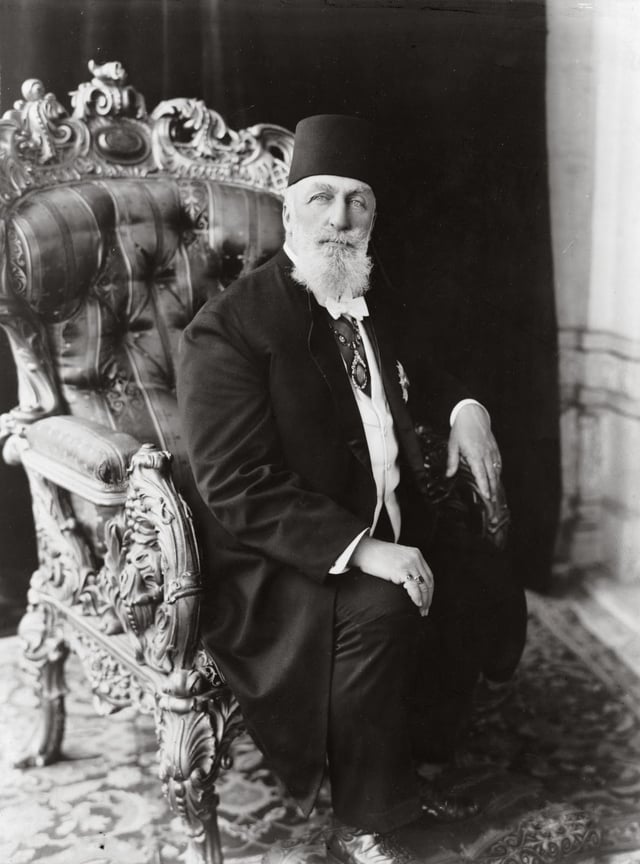
Abdülmecid II was the last Caliph of Islam from the Ottoman dynasty.
Islam spread with Muslim trade networks and Sufi orders activity that extended into Sub-Saharan Africa, Central Asia and the Malay archipelago.[274][275] Under the Ottoman Empire, Islam spread to Southeast Europe.[276] Throughout this expanse, Islam blended with local cultures everywhere, as illustrated when the prophet Mohammed showed up in Hindu epics and folklore.[277] Conversion to Islam, however, was not a sudden abandonment of old religious practices; rather, it was typically a matter of "assimilating Islamic rituals, cosmologies, and literatures into... local religious systems."[278] The Muslims in China who were descended from earlier immigration began to assimilate by adopting Chinese names and culture while Nanjing became an important center of Islamic study.[279][280]
The Turks incorporated elements of Turkish Shamanism into their new religion and became part of a new Islamic interpretation,[73] although Shamanistic influences already occurred during the Battle of Talas (752). Strikingly, Shamans were never mentioned by Muslim Heresiographers.[282]The%20Mongol%20Empire%20between%20Myth%20and%20R]]One major change was the status of woman. Unlike Arabic traditions, the Turkic traditions hold woman in higher regard in society.[281] larities between the Sufi rituals and Shaman practises.[73] However, the influence of Turkish belief was not limited to Sufism, but also to Muslims who subscribed an orthodox version of Islam in Anatolia, Central-Asia and Balkans.[73]Islam%3A%20A%20Worldwide%20Encyclopedia%20%5B4%20v]]As a result, many (formerly) Shaman traditions were considered as genuine Islamic by average Muslims.[[281]](https://openlibrary.org/search?q=Cenap%20%C3%87akmak%20 [[CITE|73|https://openlibrary.org/search?q=Cenap%20%C3%87akmak%20Islam%3A%20A%20Worldwide%20Encyclopedia%20%5B4%20v)nature spirits[283]
The majority and oldest group among Shia at that time, the Zaydis, named after the great grandson of Ali, the scholar Zayd ibn Ali, used the Hanafi jurisprudence, as did most Sunnis.[284][285][286] The Shia Safavid dynasty rose to power in 1501 and later conquered all of Iran.[287] The ensuing mandatory conversion of Iran to Twelver Shia Islam for the largely Sunni population also ensured the final dominance of the Twelver sect within Shiism over the Zaidi and Ismaili sects.[288] Nader Shah, who overthrew the Safavids, attempted to improve relations with Sunnis by propagating the integration of Shiism by calling it the Jaafari Madh'hab.[289]
Ibn Taymiyya (1263–1328) worried about the integrity of Islam and tried to establish a theological doctrine to purify Islam from its alleged alterings.[290] Unlike his contemporary scholarship, who relied on traditions and historical narratives from early Islam, Ibn Taymiyya's methodology was a mixture of selective use of hadith and a literal understanding of the Quran.[290]Encyclopedia%20of%20G]][291] ic theology instead.[290] Another major characteristic of his theological approach emphazises the significance of a Theocratic state: While the prevailing opinion held that religious wisdom was necessary for a state, Ibn Taymiyya regarded Political power as necessary for religious excellence.[290] Sahih Bukhari]] [73][292]. This not only including the invaders, but also the* [293]anthropomorphizing Ibn Kathir he anthropomorphizations,[294] but simultaneously adhered to anti-rationalistic and hadith oriented methodology of his former mentor.[295][296][297][293][290]*Encyclopedia%20of%20G]][291]Tafsir Ibn Kathir [298]
Modern era (18th – 20th centuries)
The Muslim world was generally in political decline starting the 1800s, especially relative to the non-Muslim European powers.
This decline was evident culturally; while Taqi al-Din founded an observatory in Istanbul and the Jai Singh Observatory was built in the 18th century, there was not a single Muslim-majority country with a major observatory by the twentieth century.[260] The Reconquista, launched against Muslim principalities in Iberia, succeeded in 1492. By the 19th century the British Empire had formally ended the Mughal dynasty in India.[300] In the 19th century, the Deobandi and Barelwi movements were initiated.
During the 18th century Muhammad ibn Abd al-Wahhab founded a military movement opposing the Ottoman Sultanate as an illegitimate rule, advising his fellows to return to the principles of Islam based on the theology of Ahmad ibn Hanbal.[301][271] He was deeply influenced by the works of Ibn Taymiyya and Ibn al-Qayyim and condemned many traditional Islamic practises, such as visiting the grave of Muhammad or Saints, as sin.[271] During the 18th century, he formed an alliance with the Saud family, who founded the Wahhabi sect. This revival movement allegedly seeks to uphold monotheism and purify Islam of what they see as later innovations. Their ideology led to the desecration of shrines around the world, including that of Muhammad and his companions in Mecca and Medina.[303][304] Many Arab nationalists, such as Rashid Rida, regarded the Khalifat as an Arabic right taken away by the Turks. Therefore, they rebelled against the Ottoman Sultanate, until the Ottoman Empire disintegrated after World War I and the Caliphate was abolished in 1924.[305] Concurrently Ibn Saud conquered Mekka, the "heartland of Islam", to impose Wahhabism as part of Islamic culture.[306]
At the end of the 19th century, Muslim luminaries such as Muhammad Abduh, Rashid Rida and Jamal al-Din al-Afghani sought to reconcile Islam with social and intellectual ideas of the Age of Enlightenment by purging Islam from alleged alterations and adhering to the basic tenets held during the Rashidun era.[307]The%20Making%20of%20Salafism%3A%20Islamic%20Re]]Due to their adherence to the Salafs Salafiyya[308]Salafism%20in%20Lebanon%3A%20From%20Apoliticis]][[307]](https://openlibrary.org/search?q=Henri%20Lauzi%C3%A8re%20 [[CITE|307|https://openlibrary.org/search?q=Henri%20Lauzi%C3%A8re%20*The%20Making%20of%20Salafism%3A%20Islamic%20Re) nstead, they are also often called Islamic modernists. They rejected the Sunni schools of law and allowed Ijtihad.[308]
The Ahle Sunnat movement, or as it is more popularly known, the Barelwi movement emphasizes the primacy of Islamic law over adherence to Sufi practices and personal devotion to the prophet Muhammad.[168] It grew from the writings of muhaddith and jurist Imam Ahmed Raza Khan Qadri, Allama Fazle Haq Khairabadi, Shah Ahmad Noorani and Mohammad Abdul Ghafoor Hazarvi in the backdrop of an intellectual and moral decline of Muslims in British India.[310] The movement was a mass movement, defending popular Sufism and reforming its practices, grew in response to the radical Deobandi movement in South Asia and the Wahhabi movement elsewhere.[311] The movement opposed Ahmadiyya Movement and is famous for the celebration of Mawlid. Today the movement is spread across the globe with followers in Pakistan, India, Bangladesh, Turkey, Afghanistan, Iraq, Sri Lanka, South Africa, United States, and UK among other countries. The movement now has over 200 million followers.[312]
Postmodern times (20th century–present)

The flag of the Organisation of Islamic Cooperation.
Contact with industrialized nations brought Muslim populations to new areas through economic migration.
Many Muslims migrated as indentured servants, from mostly India and Indonesia, to the Caribbean, forming the largest Muslim populations by percentage in the Americas.[313] The resulting urbanization and increase in trade in sub-Saharan Africa brought Muslims to settle in new areas and spread their faith, likely doubling its Muslim population between 1869 and 1914.[314] Muslim immigrants began arriving, many as guest workers and largely from former colonies, in several Western European nations since the 1960s.
There are more and more new Muslim intellectuals who increasingly separate perennial Islamic beliefs from archaic cultural traditions.[315] Liberal Islam is a movement that attempts to reconcile religious tradition with modern norms of secular governance and human rights. Its supporters say that there are multiple ways to read Islam's sacred texts, and they stress the need to leave room for "independent thought on religious matters".[316] Women's issues receive significant weight in the modern discourse on Islam.[317]
Secular powers such as the Chinese Red Guards closed many mosques and destroyed Qurans,[318] and Communist Albania became the first country to ban the practice of every religion.[319] About half a million Muslims were killed in Cambodia by communists who, it is argued, viewed them as their primary enemy and wished to exterminate them since they stood out and worshipped their own god.[320] In Turkey, the military carried out coups to oust Islamist governments, and headscarves were banned in official buildings, as also happened in Tunisia.[321][322]
Jamal-al-Din al-Afghani, along with his acolyte Muhammad Abduh, have been credited as forerunners of the Islamic revival.[323] Abul A'la Maududi helped influence modern political Islam.[324] Islamist groups such as the Muslim Brotherhood advocate Islam as a comprehensive political solution, often in spite of being banned.[325] In Iran, revolution replaced a secular regime with an Islamic state. In Turkey, the Islamist AK Party has democratically been in power for about a decade, while Islamist parties did well in elections following the Arab Spring.[326] The Organisation of Islamic Cooperation (OIC), consisting of Muslim-majority countries, was established in 1969 after the burning of the Al-Aqsa Mosque in Jerusalem.[327]
Religiosity appears to be deepening worldwide.[328][329][330] In many places, the prevalence of the hijab is growing increasingly common[331] and the percentage of Muslims favoring Sharia has increased.[332] With religious guidance increasingly available electronically, Muslims are able to access views that are strict enough for them rather than rely on state clerics who are often seen as stooges.[329]
It is estimated that, by 2050, the number of Muslims will nearly equal the number of Christians around the world, "driven primarily by differences in fertility rates and the size of youth populations among the world's major religions, as well as by people switching faiths."[6] Perhaps as a sign of these changes, most experts agree that Islam is growing faster than any other faith in East and West Africa.[333][334]
Denominations
Sunni
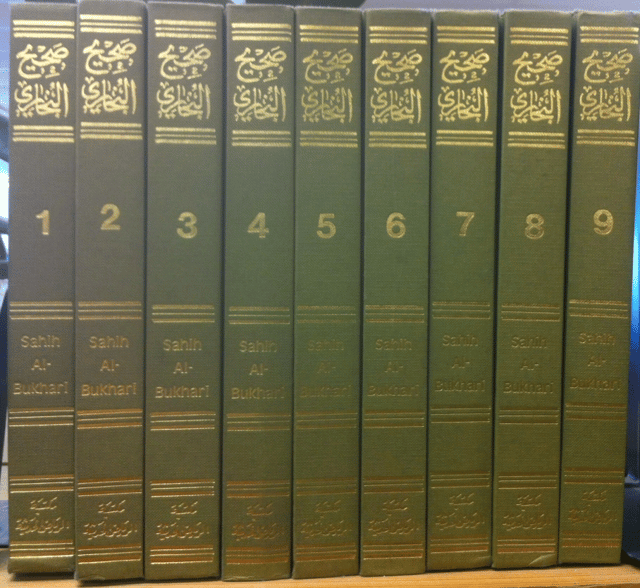
Sahih Al-Bukhari, one of the six Sunni hadith books.
Sunnis believe that the first four caliphs were the rightful successors to Muhammad; since God did not specify any particular leaders to succeed him and those leaders were elected. Further authorities regarding Sunnis believe that anyone who is righteous and just could be a caliph as long they act according to the teachings of Islam, the example of Muhammad. Alternatively, Sunnis commonly accept the companions of Muhammad as reliable for interpretating Islamic affairs.[340]
The Sunnis follow the Quran and the Hadith, which are recorded in sunni traditions known as Al-Kutub Al-Sittah (six major books). For legal matters derived from the Quran or the Hadith, many follow four sunni madh'habs (schools of thought): Hanafi, Hanbali, Maliki and Shafi'i. All four accept the validity of the others and a Muslim may choose any one that he or she finds agreeable.[341]
Sunni schools of theology encompass Ashʿarirism founded by Al-Ashʿarī (c. 874–936), Maturidi by Abu Mansur al-Maturidi (853–944 CE) and Traditionalist theology under the leadership of Ahmad ibn Hanbal (780–855 CE). Traditionalist theology is characterized by its adherence to a literal understanding of the Quran and the Sunnah, the belief in the Quran to be uncreated and eternal, and opposes reason (kalam) in religious matters.[342]Islam%20and%20Secularism%20in%20Post-Colonial]]On the other hand, Maturidism asserted that and can be understand by reason alone.[[343]](https://openlibrary.org/search?q=Rico%20Isaacs%2C%20Alessandro%20Frigerio%20 [[CITE|343|https://openlibrary.org/search?q=Rico%20Isaacs%2C%20Alessandro%20Frigerio%20*Theorizing%20Centr) ding a doctrinal framework for more flexibility, adaptability and syncretism. Maturidism especially flourished in Central-Asia.[236] Nevertheless, people would rely on revelation, because reason alone could not grasp the whole truth. Asharism holds, ethics can just derive from divine revelation, but not from human reason. However, Asharism accepts reason in regard of exegetical matters and combined Muʿtazila approaches with traditionalistic ideas.[345]
In the 18th century, Muhammad ibn Abd al-Wahhab led a Salafi movement, referred by outsiders as Wahhabism, in modern-day Saudi Arabia. Originally shaped by Hanbalism, many modern followers departed from any of the established four schools of law Hanafi, Shafi, Maliki, and Hanbali.[293] Similarly, Ahl al-Hadith is a movement that deemphasized sources of jurisprudence outside the quran and hadith, such as informed opinion (ra'y).The Deobandi movement is a reformist movement originating in South Asia, influenced by the Wahhabi movement.[217]
Nurcu is a Sunni movement based on the writings of Said Nursi (1877 – 1960) founded at the beginning of the twentieth century.[348] His philosophy is based on Hanafi law and further incorporates elements of Sufism.[348] He emphasized the importance of salvation in both life and afterlife through education and freedom, the synthesis of Islam and science and democracy as the best form governance within the rule of law.[349] Through faith by inquiry instead of faith by imitation, Muslims would reject philosophies such as positivism, materialism and atheism emerging from the Western world of his time.[348] His notion of sharia is twofold: On one hand, sharia applies to the voluntary actions of human beings. On the other hand, sharia denotes the set of laws of nature, but both ultimately derive from one source, which is God.[349][351]Nurcu Gülen movement derived.
Shia
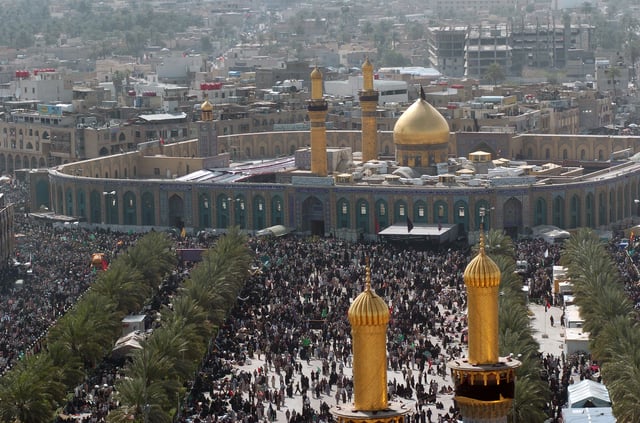
The Imam Hussein Shrine in Karbala, Iraq is a holy site for Shia Muslims.
The Shia constitute 10–20% of Islam and are its second-largest branch.[30]
While the Sunnis believe that a Caliph should be elected by the community, Shia's believe that Muhammad appointed his son-in-law, Ali ibn Abi Talib, as his successor and only certain descendants of Ali could be Imams. As a result, they believe that Ali ibn Abi Talib was the first Imam (leader), rejecting the legitimacy of the previous Muslim caliphs Abu Bakr, Uthman ibn al-Affan and Umar ibn al-Khattab. Other points of contention include certain practices viewed as innovating the religion, such as the mourning practice of tatbir, and the cursing of figures revered by Sunnis. However, Jafar al-Sadiq himself disapproved of people who disapproved of his great grand father Abu Bakr and Zayd ibn Ali revered Abu Bakr and Umar.[352]%20by%20Tabar%C4%AB%2C%20C]][[353]](https://openlibrary.org/search?q= [[CITE|353|https://openlibrary.org/search?q=The%20Encyclopedia%20of%20Religion%20Vol.16%2C%20Mircea%20Elia)Grand Ayatollah Ali Khamenei[354]Ali al-Sistani[355] condemned the practice.
Shia Islam has several branches, the most prominent being the Twelvers (the largest branch), Zaidis and Ismailis. Different branches accept different descendants of Ali as Imams. After the death of Imam Jafar al-Sadiq who is considered the sixth Imam by the Twelvers and the Ismaili's, the Ismailis recognized his son Isma'il ibn Jafar as his successor whereas the Twelver Shia's (Ithna Asheri) followed his other son Musa al-Kadhim as the seventh Imam. The Zaydis consider Zayd ibn Ali, the uncle of Imam Jafar al-Sadiq, as their fifth Imam, and follow a different line of succession after him. Other smaller groups include the Bohra as well as the Alawites and Alevi.[356] Some Shia branches label other Shia branches that do not agree with their doctrine as Ghulat.
Other denominations
Ahmadiyya is an Islamic reform movement (with Sunni roots) founded by Mirza Ghulam Ahmad[357] that began in India in 1889 and is practiced by 10 to 20 million[358] Muslims around the world. Ahmad claimed to have fulfilled the prophecies concerning the arrival of the 'Imam Mahdi' and the 'Promised Messiah'.
Bektashi Alevism is a syncretic and heterodox local Islamic tradition, whose adherents follow the mystical (bāṭenī) teachings of Ali and Haji Bektash Veli.[359] Alevism incorporates Turkish beliefs present during the 14th century,[360] such as Shamanism and Animism, mixed with Shias and Sufi beliefs, adopted by some Turkish tribes.
The Ibadi is a sect that dates back to the early days of Islam and is a branch of Kharijite and is practiced by 1.45 million Muslims around the world.[361] Unlike most Kharijite groups, Ibadism does not regard sinful Muslims as unbelievers.
Mahdavia is an Islamic sect that believes in a 15th-century Mahdi, Muhammad Jaunpuri
The Quranists are Muslims who generally reject the Hadith.
Non-denominational Muslims
Non-denominational Muslims is an umbrella term that has been used for and by Muslims who do not belong to or do not self-identify with a specific Islamic denomination.[362][363][364] Prominent figures who refused to identify with a particular Islamic denomination have included Jamal ad-Din al-Afghani,[365] Muhammad Iqbal[366] and Muhammad Ali Jinnah.[367] Recent surveys report that large proportions of Muslims in some parts of the world self-identify as "just Muslim", although there is little published analysis available regarding the motivations underlying this response.[172][368][369][370] The Pew Research Center reports that respondents self-identifying as "just Muslim" make up a majority of Muslims in seven countries (and a plurality in three others), with the highest proportion in Kazakhstan at 74%. At least one in five Muslims in at least 22 countries self-identify in this way.[172]
Derived religions
Some movements, such as the Druze, Berghouata and Ha-Mim, either emerged from Islam or came to share certain beliefs with Islam and whether each is a separate religion or a sect of Islam is sometimes controversial. Yazdânism is seen as a blend of local Kurdish beliefs and Islamic Sufi doctrine introduced to Kurdistan by Sheikh Adi ibn Musafir in the 12th century. Bábism stems from Twelver Shia passed through Siyyid 'Ali Muhammad i-Shirazi al-Bab while one of his followers Mirza Husayn 'Ali Nuri Baha'u'llah founded the Bahai Faith.[371] Sikhism, founded by Guru Nanak in late-fifteenth-century Punjab, incorporates aspects of both Islam and Hinduism. African American Muslim movements include the Nation of Islam, Five-Percent Nation and Moorish scientists.
Demographics

World Muslim population by percentage (Pew Research Center, 2014).

Skyline of Jakarta, capital of Indonesia, the most populous Muslim-majority country.
A comprehensive 2019 demographic study of 232 countries and territories reported that 24.4% of the global population, or 1.9 billion people, are Muslims.
Of those, it is estimated that over 75–90% are Sunni and 10–20% are Shia[372][59][30] with a small minority belonging to other sects. Approximately 57 countries are Muslim-majority,[374] and Arabs account for around 20% of all Muslims worldwide.[375]Muslims%20in%20]]The number of Muslims worldwide increased from 200 million in 1900 to 551 million in 1970,[[376]](https://openlibrary.org/search?q=Whaling%2C%20Frank%20%281987%29.%20 [[CITE|376|https://openlibrary.org/search?q=Whaling%2C%20Frank%20%281987%29.%20*Religion%20in%20today's%20world%3A)[6]
The majority of Muslims live in Asia and Africa.[377] Approximately 62% of the world's Muslims live in Asia, with over 683 million adherents in Indonesia, Pakistan, India, and Bangladesh.[378][379] In the Middle East, non-Arab countries such as Turkey and Iran are the largest Muslim-majority countries; in Africa, Egypt and Nigeria have the most populous Muslim communities.
Most estimates indicate that the China has approximately 20 to 30 million Muslims (1.5% to 2% of the population).[380][381][382] However, data provided by the San Diego State University's International Population Center to U.S. News & World Report suggests that China has 65.3 million Muslims.[378] Islam is the second largest religion after Christianity in many European countries,[384] and is slowly catching up to that status in the Americas, with between 2,454,000, according to Pew Forum, and approximately 7 million Muslims, according to the Council on American–Islamic Relations (CAIR), in the United States.[372][385]
According to the Pew Research Center, Islam is set to equal Christianity worldwide in number of adherents by the year 2050. Islam is set to grow faster than any other major world religion, reaching a total number of 2.76 billion (an increase of 73%). Causes of this trend involve high fertility rates as a factor, with Muslims having a rate of 3.1 compared to the world average of 2.5, and the minimum replacement level for a population at 2.1. Another factor is also due to fact that Islam has the highest number of adherents under the age of 15 (34% of the total religion) of any major religion, compared with Christianity's 27%. 60% of Muslims are between the ages of 16 and 59, while only 7% are aged 60+ (the smallest percentage of any major religion). Countries such as Nigeria and North Macedonia are expected to have Muslim majorities by 2050. In India, the Muslim population will be larger than any other country. Europe's non-Muslim population is set to decline as opposed to their Muslim population which is set to grow to 10% of Europe's total.[6] Growth rates of Islam in Europe was due primarily to immigration and higher birth rates of Muslims in 2005.[386]
Culture
The term "Islamic culture" could be used to mean aspects of culture that pertain to the religion, such as festivals and dress code. It is also controversially used to denote the cultural aspects of traditionally Muslim people.[387] Finally, "Islamic civilization" may also refer to the aspects of the synthesized culture of the early Caliphates, including that of non-Muslims,[388] sometimes referred to as "Islamicate".
Architecture
Perhaps the most important expression of Islamic architecture is that of the mosque.[389] Varying cultures have an effect on mosque architecture. For example, North African and Spanish Islamic architecture such as the Great Mosque of Kairouan contain marble and porphyry columns from Roman and Byzantine buildings,[390] while mosques in Indonesia often have multi-tiered roofs from local Javanese styles.
Art
Islamic art encompasses the visual arts produced from the 7th century onwards by people (not necessarily Muslim) who lived within the territory that was inhabited by Muslim populations.[391] It includes fields as varied as architecture, calligraphy, painting, and ceramics, among others.
While not condemned in the Quran, making images of human beings and animals is frowned on in many Islamic cultures and connected with laws against idolatry common to all Abrahamic religions, as 'Abdullaah ibn Mas'ood reported that Muhammad said, "Those who will be most severely punished by Allah on the Day of Resurrection will be the image-makers" (reported by al-Bukhaari, see al-Fath, 10/382). However this rule has been interpreted in different ways by different scholars and in different historical periods, and there are examples of paintings of both animals and humans in Mughal, Persian and Turkish art. The existence of this aversion to creating images of animate beings has been used to explain the prevalence of calligraphy, tessellation and pattern as key aspects of Islamic artistic culture.[392]
Music
Poetry
Calendar

The phases of the Moon form the basis for the Islamic calendar
The formal beginning of the Muslim era was chosen, reportedly by Caliph Umar, to be the Hijra in 622 CE, which was an important turning point in Muhammad's fortunes. It is a lunar calendar with days lasting from sunset to sunset.[393] Islamic holy days fall on fixed dates of the lunar calendar, which means that they occur in different seasons in different years in the Gregorian calendar. The most important Islamic festivals are Eid al-Fitr (Arabic: عيد الفطر) on the 1st of Shawwal, marking the end of the fasting month Ramadan, and Eid al-Adha (عيد الأضحى) on the 10th of Dhu al-Hijjah, coinciding with the end of the Hajj pilgrimage.[394]
Criticism
John of Damascus viewed Islamic doctrines as nothing more than a hodgepodge culled from the Bible.[395]
Criticism of Islam has existed since Islam's formative stages.
Early criticism came from Christian authors, many of whom viewed Islam as a Christian heresy or a form of idolatry and often explained it in apocalyptic terms.[396] Later there appeared criticism from the Muslim world itself, and also from Jewish writers and from ecclesiastical Christians.[397]Leaving%20Islam%3A%20Apostates%20Spea]][[398]](https://openlibrary.org/search?q=Kammuna%2C%20Ibn%20%281971%29.%20 [[CITE|398|https://openlibrary.org/search?q=Kammuna%2C%20Ibn%20%281971%29.%20*Examination%20of%20the%20Three%20Fai)[399][400] Islamic salvation optimism and its carnality was criticized by Christian writers. Islam's sensual descriptions of paradise led many Christians to conclude that Islam was not a spiritual religion. Although sensual pleasure was also present in early Christianity, as seen in the writings of Irenaeus, the doctrines of the former Manichaean Augustine of Hippo led to broad repudiation of bodily pleasure in both life and the afterlife. Ali ibn Sahl Rabban al-Tabari defended the Quranic description of paradise by asserting that the Bible also implies such ideas, such as drinking wine in Gospel of Matthew.
Since the events of September 11, 2001, Islam has faced criticism over its scriptures and teachings being a significant source of terrorism and terrorist ideology.[403][404]
Other criticisms focus on the question of human rights in modern Muslim-majority countries, and the treatment of women in Islamic law and practice.[405][406] In wake of the recent multiculturalism trend, Islam's influence on the ability of Muslim immigrants in the West to assimilate has been criticized.[407] Both in his public and personal life, others objected the morality of Muhammad, therefore also the sunnah as a role model.[399][408]
See also
Glossary of Islam
Index of Islam-related articles
Ahkam
Challenge of the Quran
Fard
Islam and other religions
Islamic ethics
Islam in Asia
Islamic literature
Islamic mythology
Islamic studies
List of Muslim empires and dynasties
List of notable converts to Islam
Lists of Muslims
Major religious groups
Persecution of Muslims
Religious conversion#Islam
Timeline of Islamic history
Wasatiyyah (Islamic term)
References
- , pp. 111–112, 118) "Shari'ah". Encyclopædia Britannica Online.
